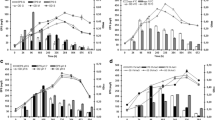Abstract
A marine Pseudomonas sp. S9 produced and released an extracellular polysaccharide during complete energy and nutrient starvation in static conditions. The presence of the polysaccharide on the cell surface, demonstrable by immune transmission electron microscopy, correlated with changes in the degree of adhesion to hydrophobic surfaces. Polysaccharide coated cells showed a lower degree of adhesion than did cells devoid of the polymer. After 10 h of starvation, no ruthenium red stained antibody stabilized polysaccharides could be observed on the cell surface. The polysaccharide was not produced during growth since lysates of mid-log phase cells did not precipitate the antiserum. The relative proportions of sugars in the polysaccharide were 28% glucose, 35% N-acetylglucosamine and 37% N-acetylgalactosamine. The released polysaccharide did not significantly alter the physical parameters of surface tension and viscosity of the starvation regime. Cells starved in agitated conditions did not produce any extracellular polysaccharides and exhibited a different adhesion pattern to hydrophobic surfaces.
Similar content being viewed by others
Abbreviations
- FSS:
-
Four salt solution
- GLC:
-
gas liquid chromatography
- MS:
-
Mass spectrometry
- NSS:
-
nine salt solution
References
Absolom DR, Lamberti FV, Policova Z, Zingg W, van Oss CJ, Neumann AW (1983) Surface thermodynamics of bacterial adhesion. Appl Environ Microbiol 46:90–97
Bradford MM (1976) A rapid and sensitive method for the quantitation of microgram quantities of protein utilizing the principle of protein-dye binding. Analyt Biochem 72:248–254
Costerton JW, Irvin RT, Cheng KJ (1981) The bacterial glycocalyx in nature and desease. Annu Rev Microbiol 351:299–324
Costerton JW, Marrie TJ, Cheng KJ (1985) Phenomena of bacterial adhesion. In: Savage DC, Fletcher M (eds) Bacterial adhesion. Plenum Publ Corp, New York, pp 3–43
Dahlbäck B, Gunnarsson LÅH, Hermansson M, Kjelleberg S (1982) Microbial investigations of surface microlayers, water column, ice and sediment in the Arctic Ocean. Mar Ecol 9:101–109
Davis CL (1985) Physiological and ecological studies of mannitol utilizing marine bacteria. Ph D thesis, University of Cape Town, South Africa
Dawson MP, Humphrey BA, Marshall KC (1981) Adhesion: a tactic in the survival strategy of a marine vibrio during starvation. Curr Microbiol 6:195–198
Fattom A, Shilo M (1985) Production of emulcyan by Phormidium J-1: its activity and function. FEMS Microb Ecol 31:3–9
Fletcher M (1985) Effect of solid surfaces on the activity of attached bacteria. In: Savage DC, Fletcher M (eds) Bacterial adhesion. Plenum Publ Corp, New York, pp 339–362
Fletcher M, Floodgate G (1976) The adhesion of bacteria to solid surfaces. In: Fuller R, Lovelock DW (eds) Microbial ultrastructure. Academic Press, London, pp 101–107
Geesey GG (1982) Microbial exopolymers: ecological and economic considerations. ASM-News 48:9–14
Hogt AH, Dankert J, Feijen J (1983) Encapsulation, slime production and surface hydrophobicity of coagulase negative staphylococci. FEMS Microbiol Letters 18:211–215
Humphrey B, Kjelleberg S, Marshall KC (1983) Responses of marine bacteria under starvation conditions at a solid-water interface. Appl Environ Microbiol 45:43–47
Jansson PE, Kenne L, Lindberg B, Lindgren A, Lönngren J (1976) A practical guide to the methylation analyses of carbohydrates. Chem Commun 8:1–75
Kjelleberg S, Humphrey BA, Marshall KC (1982) Effect of interfaces on small starved marine bacteria. Appl Environ Microbiol 43:1166–1172
Kjelleberg S, Humphrey BA, Marshall KC (1983) Initial phases of starvation and activity of bacteria at surfaces. Appl Environ Microbiol 46:978–984
Mården P, Tunlid A, Malmcrona-Friberg M, Odham G, Kjelleberg S (1985) Physiological and morphological changes during short term starvation of marine bacterial isolates. Arch Microbiol 142:326–332
Maroudas NG (1975) Polymer exclusion, cell adhesion and membrane fusion. Nature 254:695–696
Marshall KC (1985) Mechanisms of bacterial adhesion of solidwater interfaces. In: Savage DC, Fletcher M (eds) Bacterial adhesion. Plenum Publ Corp, New York, pp 133–161
Morita RY (1982) Starvation-survival of heterotrophs in the marine environment. In: Marshall KC (ed) Advances in microbial ecology, vol 6. Plenum Publ Corp, New York, pp 171–189
Ofek I, Whitnack E, Beachey EH (1983) Hydrophobic interactions of group A streptococci with hexadecane droplets. J Bacteriol 154:139–145
Oliver JD, Colwell RR (1973) Extractable lipids of Gram negative marine bacteria: fatty-acid composition. Int J Syst Bacteriol 23:442–458
Paul JH, Heffrey WH (1985) Evidence for separate adhesion mechanisms for hydrophilic and hydrophobic surfaces in Vibrio proteolytica. Appl Environ Microbiol 50:431–437
Pringle JH, Fletcher M (1983) Influence of substratum wettability on attachment of fresh water bacteria to solid surfaces. Appl Environ Microbiol 45:811–817
Reynolds ES (1963) The use of lead citrate at high pH as an electron opaque stain in electron microscopy. J Cell Biol 17:208–212
Rosenberg M, Kjelleberg S (1986) Hydrophobic interactions: role in bacterial adhesion. In: Marshall KC (ed) Advances in microbial ecology, vol 9. Plenum Publ Corp, New York (in press)
Rosenberg E, Gottlieb A, Rosenberg M (1983) Inhibition of bacterial adherence to hydrocarbon and epithelial cells by Emulsan. Infect Immun 39:1024–1028
Runnels PL, Moon HW (1984) Capsule reduces adherence of enterotoxigenic Escherichia coli to isolated intestinal epithelial cells of pigs. Infect Immun 45:737–740
Rutter PR (1980) The physical chemistry of the adhesion of bacteria and other cells. In: Curtis ASG, Pitts JD (eds) Cell adhesion and motility. British Society for Cell Biology, Symposium 3, Cambridge University Press, Cambridge, pp 103–135
Sawardeker JS, Sloneker JH, Jeanes AR (1965) Quantitative determination of monosaccharides as their alditolacetates by gas liquid chromatography. Analyt Chem 37:1602–1604
Spurr AR (1969) A low-viscosity epoxy resin: embedding medium for electron microscopy. J Ultrastruct Res 26:31–43
Sutherland IW (1977) Bacterial exopolysaccharides — their nature and production. In: Sutherland IW (ed) Surface carbohydrates of the procaryotic cell. Academic Press, London, pp 27–96
Sutherland IW (1985) Biosynthesis and composition of Gram-negative bacterial extracellular and wall polysaccharides. Ann Rev Microbiol 39:243–270
Author information
Authors and Affiliations
Rights and permissions
About this article
Cite this article
Wrangstadh, M., Conway, P.L. & Kjelleberg, S. The production and release of an extracellular polysaccharide during starvation of a marine Pseudomonas sp. and the effect thereof on adhesion. Arch. Microbiol. 145, 220–227 (1986). https://doi.org/10.1007/BF00443649
Received:
Accepted:
Issue Date:
DOI: https://doi.org/10.1007/BF00443649




